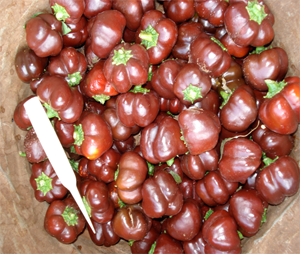| A research conducted at Rutgers University in the U.S.A compares vegetables grown organically and using synthetic fertilizers and pesticides. The research has clearly proven that Organic is better! Here is the link, check it out: http://www.organicnutrition.co.uk/whyorganic/whyorganic.htm
Organically grown vegetables contain 2 times more phosphorus, 3 to 6 times more Calcium, 3 to 10 times more Magnesium, 2 to 3 times more Potassium, 5 to 10 times more Boron, up to 100 times more Manganese, up to 50 times more Iron, up to 100 times more Copper… |
 |
Some Facts about Organic Heritage Seeds!
Nutrition values of some of the Heritage’s varieties :
- A tomato variety called “Double rich” contains 2 times more Vitamin C than most of oranges!
- Another tomato variety called “Caro“, has a very high content of Vitamin A and contains 10 to 12 times more beta-carotene than other tomatoes!
- These tomatoes have an average between 15 to 17 amino acids among the 20 essential ones for the elaboration of protein in human metabolism!
- In Orange tomatoes there is between 6 to 12 times more B carotene than in red tomatoes!
- Capsicum variety called Miniature Chocolate bell has higher antioxidant capacity and high carotenoids. People consuming diets rich in carotenoids from natural foods, such as fruits and vegetables, are healthier and have lower mortality from a number of chronic illnesses. (http://en.wikipedia.org/wiki/Carotenoid)
Go Organic, Go for Natural Organic Seed!!
It’s safer |
 |
 |
- Unless you eat organic one item in three in your fridge or kitchen cupboard is likely to contain chemical residues which often occur in potentially dangerous combinations.
- Health problems as diverse as heart disease, osteoporosis, migraines and hyperactivity have been linked to food additives whose use is banned in organic food production.
|
It’s more nutritious and diseases can be avoided!!!
- We are exposed to between 300 and 500 toxins in our food and our environment – more than ever before
- Nutrient deficiencies are very common: so many of us are overfed and undernourished. Official data show that over the past half century there’s been an alarming decline in mineral levels in fruit and vegetables.
- Nutrient levels are 85% higher in organic soils
- On average, research has found higher Vitamin C, higher mineral levels and higher phyto-nutrients – plant compounds in Organic products, which can be effective against cancer.
- Alternative cancer therapies have achieved good results relying on the exclusive consumption of organic food
- *Additionally, according to “Coronary and Diabetic Care in the UK 2004” by the Association of Primary Care Groups and Trusts (UK), written by James Cleeton, Policy Projects Coordinator at the Soil Association, a predominantly organic diet:
|
Reduces the amount of toxic chemicals ingested;
- Avoids genetically modified organisms (GMOs);
- Reduces the amount of food additives and colorings ingested;
- Increases the amount of beneficial vitamins, minerals, essential fatty acids (like omega 3 and omega 6) and antioxidants consumed; and
- Appears to have the potential to lower the incidence of common conditions, such as cancer, coronary heart disease, allergies, and hyperactivity in children.
*http://www.veghealthguide.com/organic-produce/ |
Why should we plant DIVERSITY in our Farms and Gardens?
Among the tomatoes, you can plant a diversity such as : |
- Cherry tomatoes, which are hardy and early, really productive, extremely sweet, almost like berries and loved by children.
Along with
- one medium-size fruited orange tomato for its nutritional values (C vitamin) for salads as much as for its productivity.
A hearty combination could be |
 |
- a big-fruited Oxheart variety, red, orange, pink or a big- size yellow tomato which is more delicate and looks so attractive in the garden and in the family lunch box which
Then,
- a medium-size red tomato to ensure a regular supply to the family.
Choose to use this rich diversity and seek her benefits against disease and crop failures |
|
|
|







